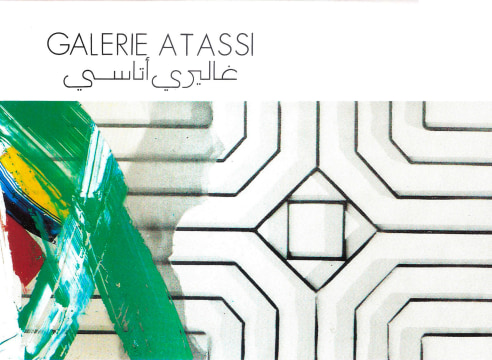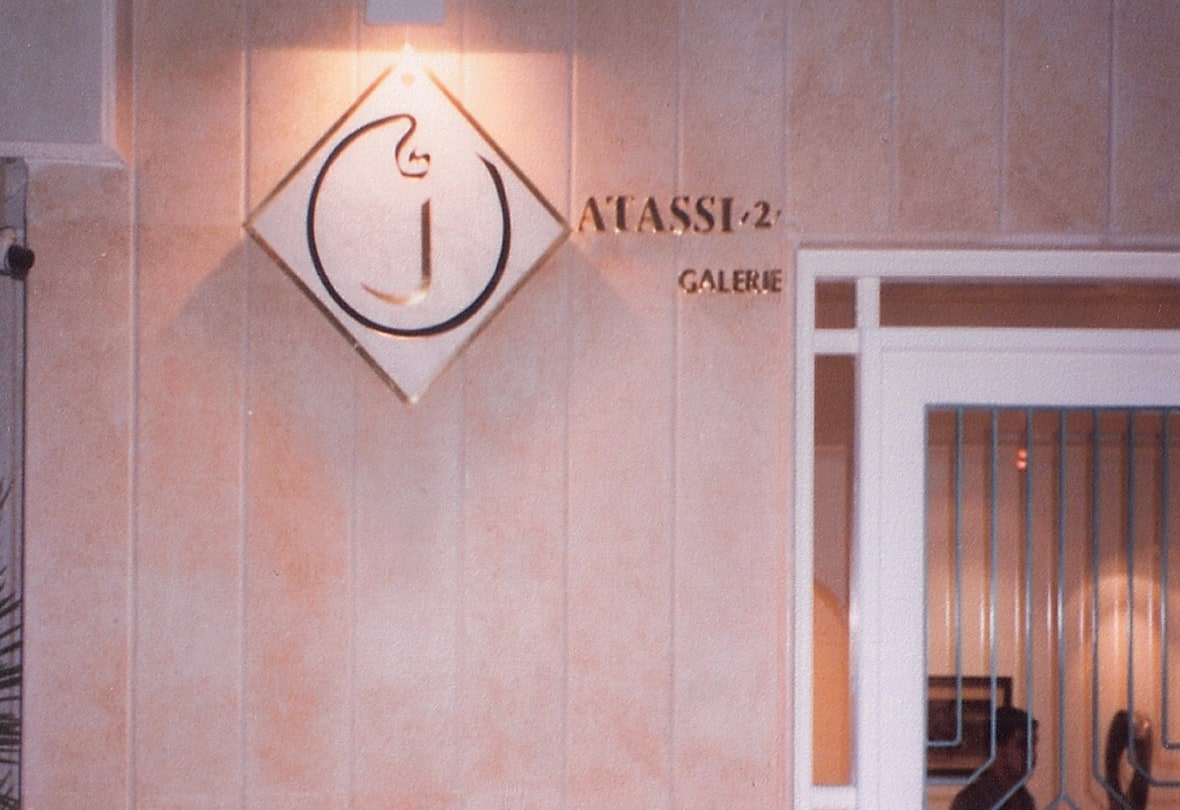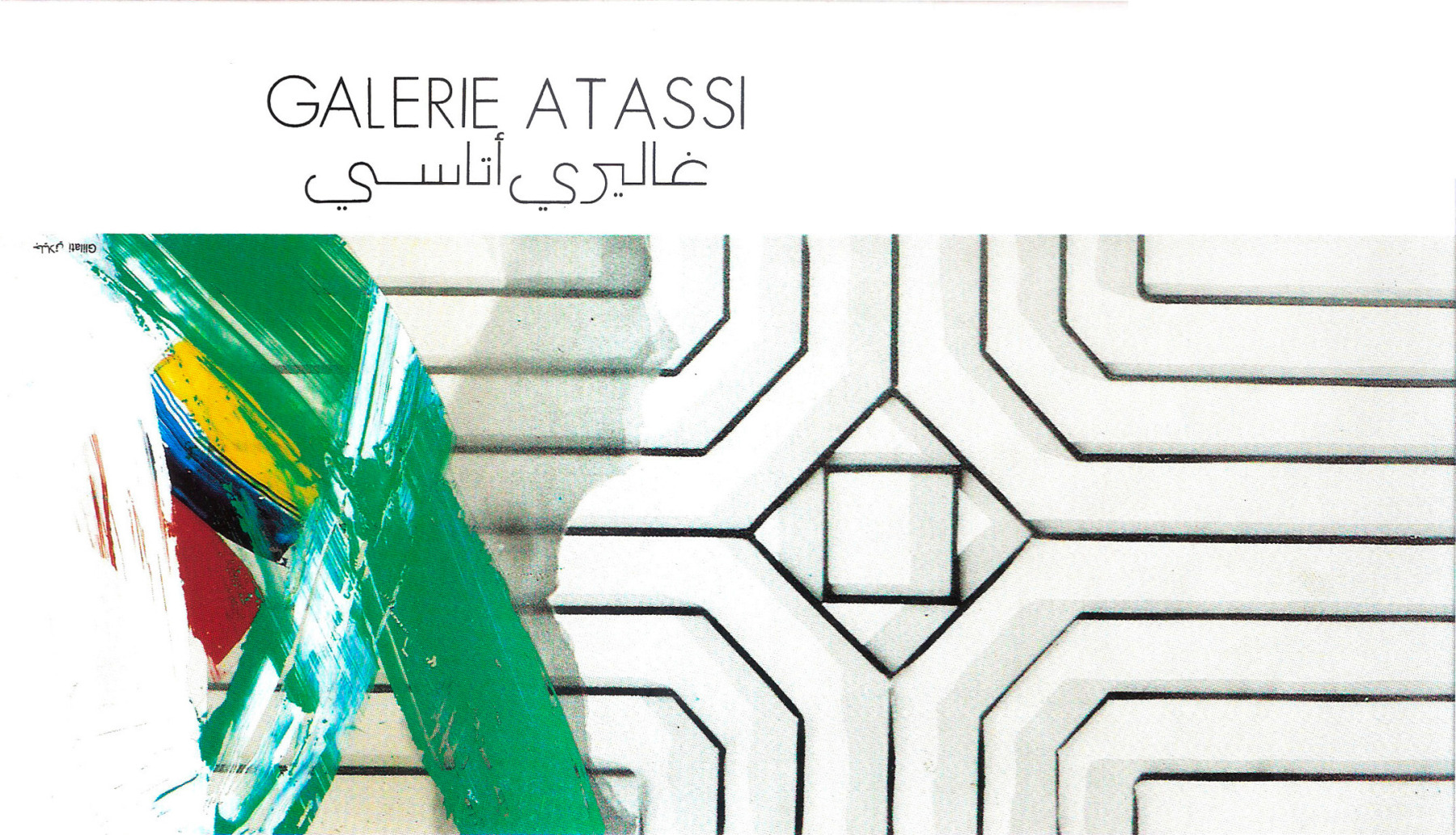

This archive represents part of the holdings of the Atassi Gallery and consists of documentary material related to its activities in Damascus, in particular the 98 exhibitions that the gallery staged between its opening in 1993 and its closure in 2010.
The material includes three types of documents:
- Publications of the Atassi Gallery, including invitation cards, pamphlets, and introductory texts that accompanied the exhibitions, as well as catalogues and posters.
- Photographic records of exhibition openings and cultural events at the gallery.
- Reviews and critical writing published in the local, regional, and international Arab-language press.
For the duration of its existence, the Atassi Gallery put on an average of six exhibitions a year, the majority of them solo shows for Syrian artists. The very first event held in the space was an exhibition showcasing the work of three artists, Mahmoud Hammad (1923-1988), Louay Kayali (1934-1978), and Fateh Moudarres (1922-1999). In 1995, the gallery staged a well-publicised exhibition for Youssef Abdelke (b.1951)—an artist who had not been exhibited for many years—then in 1997 it published a book about Fateh Moudarres to mark a retrospective exhibition in Damascus, which coincided with another exhibition of his work in Paris that same year, at the Institut du Monde Arabe. The book contained an introduction by Mouna Atassi and texts by the poet Adonis, writer Ibrahim Alaiwy, artist and critic Asaad Arabi, and Moudarres himself. That same year the gallery held another retrospective, this time for Marwan Kassab-Bachi, which travelled first to Cairo, then to the Khalid Shoman Foundation’s Darat al-Funun in Amman, Jordan, where a talk was given by the novelist Abdul Rahman Munif, a great supporter of Kassab-Bachi’s work. The atelier’s next project was a show on the Paris-based Ziad Dalloul (b.1953) and the publication of a book on the artist containing a poetic text by Adonis and an introductory essay by Asaad Arabi.
The exhibitions continued in 1998, perhaps the most notable of which was an exhibition by Ahmad Moualla (b.1958) dedicated to the playwright Saadallah Wannous. The exhibition caused quite a stir at the time, as Moualla’s installation completely altered the gallery’s appearance, and involved the dramatic introduction of large quantities of black sand into the space. Moualla discussed his piece and its relationship to the theatre (particularly the work of Wannous) in a talk given at the Arab Institute for French Studies, as well as in the catalogue, which contained a text written by the artist alongside excerpts from a conversation between Dr. Marie Elias and Saadallah Wannous and a text about Moualla by the poet Nazih Abu Afash. Having introduced this new type of exhibition to Syria, the Atassi Gallery began to pay increasing attention to the younger generation of Syrian artists, exhibiting a collection of watercolours by Khaled Takriti (b.1964), and in 1998, a show by Safwan Dahoul (b.1961), who had just completed his studies in Belgium.
This year marked a turning point in the Atassi Gallery’s development, with the publication of Contemporary Art in Syria: 1898-1998, with an introduction by Mouna Atassi and texts by Adonis, Tariq Sharif, and Elias Zayat. The book was the fruit of many years of conversations and interviews with artists and art-specialists, not only in the Atassi Gallery, but in the homes and studios of the artists themselves, that focused on the history of artistic movements in Syria. In addition to documenting and archiving these encounters, the book created a photographic record of artworks in the national museums of Aleppo and Damascus and in the artists’ studios. The book’s publication was formally announced at a celebration in the garden of the Damascus National Museum in that same year, and in the month that followed a series of talks and exhibitions were held on the art and artists it discussed.
The following year saw another important exhibition. Ateliers Syriens was staged in Beirut to mark the city’s selection as Arab Cultural Capital in conjunction with a conference at the UNESCO Palace to celebrate Syrian Art. The exhibition was subsequently relocated to the Khan As’ad Pasha in Damascus. In his guide accompanying the exhibition, Asaad Arabi wrote a text on The Aesthetics of the Syrian Workshop. The importance of this event was that it sought to promote Syrian artistic production in a neighbouring country with a very different cultural and economic make-up. In addition, the Atassi Gallery released video recordings with the same title as the exhibition in which Fateh Moudarres, Elias Zayyat, Nazir Nabaa (1938-2016), Ahmad Moualla, Lotfi al-Romhein (b.1954), Nizar Sabour (b.1958), and Mustafa Ali (b.1956) discussed the visual, sentimental, and intellectual inspirations and sources behind the work; the recordings were accompanied by images of the artworks that made up the exhibition.
The exhibition of work by Asaad Arabi, also from 1999, generated a series of important critical discussions and texts in response to the artist’s standing as critic deeply-versed in the philosophy of art and its various schools, both regionally and internationally. This included an interview with Arabi published in al-Mustaqbal on October 26, 1999, entitled, Art is not a search for technique and then another in al-Kifah al-Arabi on November 16, entitled, The fine arts are an elitist, individualistic pursuit and a collective achievement. The profound concern for culture and knowledge shown in these public talks and publications, by the Atassi Gallery and the Syrian artists who exhibited there, is a quality shared by artists from other Arab countries. For instance, the Iraqi artist Jaber Alwan, stated that, “the canvas is perpetual angst and the exhibition is a cultural project,” in an interview published by the al-Thawra newspaper’s cultural supplement on October 17 that coincided with his own exhibition in Damascus.
Indeed, alongside Syrian works, the Atassi Gallery always showcased important and influential artists from around the Arab world, including Hussein Madi (Lebanese: b.1938) in 1993, Kamal Boullata (Palestinian: 1942-2019) in 1994, Samir Sayegh (Lebanese: b.1954) and Samia Halaby (Lebanese-American: b.1936) in 1997, Jaber Alawan (Iraqi: b.1948) in 1999, and Asaad Arabi (Lebanese: b.1941) in 1999. They have also exhibited artists from outside the region, such as Kazimierz Pomagalski in 1996, Holger Matthies in 1997, Franziskus Wendels in 1998, and the Venezuelan ambassador Hernani Escobar in 1999.
It is noticeable how unusual it was to see female artists exhibit in this milieu. Some instances include Shalabiya Ibrahim (b.1944) and Hala Mahayni (b.1947) in the 1994 exhibition Still Nature, or the Four Experiments exhibition in 1999 that showcased work by Lujaina al-Aseel, Asma Fayoumi, Hala Mahayni and Doha Qadasi. The lack was due to the difficulty women faced in dedicating themselves to art at this period in Syrian history, itself the product of a number of factors that the artist and researcher Nagham Hodaifa explored in her essay, The Female in Syrian Art, itself a chapter in the publication, Personal Revolutions, published by the Atassi Foundation in 2019.
Exhibitions always staged talks and discussions, a characteristic of the Syrian art scene since the 1960s that has continued to the present day. As part of its second-ever exhibition, a show by Ghayath al-Akhras (b.1937) entitled, Greetings to Fateh, a discussion was held on tradition and modernity that included the author Antun Maqdisi, critic Salah al-Din Mohammed, and artists Fateh Moudarres, Elias Zayyat, and Ghayath al-Akhras. In 1994, Abdullah Mourad’s exhibition was accompanied by a debate between art historian Tariq Sharif, and Fateh Moudarres, Ghayath al-Akhras, and Abdullah Mourad himself, whose conclusions about the role and nature of art criticism was subsequently discussed by Saad al-Qasem in an article entitled, On Mourad’s exhibition and its debate. This was published in a local newspaper but the archive’s photocopy is unfortunately missing the name of the publication. Palestinian artist Kamal Boullata gave a lecture in 1994 on the occasion of his own exhibition, in which he spoke about the work of Jerusalem artists in exile.
The Atassi Gallery did not confine its efforts to public discussions and debates. Its catalogues were an equally important part of its efforts to promote understanding. For instance: the catalogue it published in 1994 on Marwan Kassab-Bachi, which contained reproductions of his work and a text by Abdul Rahman Munif. The idea behind the exhibition was to display works produced on paper and move away from the conventional (and deeply-rooted) conviction that all artworks had to be painted on canvas.

The relatively late arrival of a publicly available internet in 2000 marked a watershed moment in Syria’s cultural landscape. Firstly, it constituted a cultural and epistemological ‘opening up’ with the ability to access the sites of major international museums and libraries. These helped to fill the gap created by a lack of artistic resources and the inability of many people to visit exhibitions, which were held almost exclusively in Damascus and Aleppo.
At the same time, discussions around issues such as the role played by artists and galleries in society – which had been the main preoccupation of art criticism and journalism in the 1990s – began to give way to issues of art-theory. For instance: to which school an artist might belong, or how to derive an aesthetic from tradition, particularly with regards to colour and form, but also from what artist Khaled Al Saai (b.1970) has referred to as “the expressive medium” of the Arabic letterforms.
The newspaper clippings available within this archive document a growing interest in positioning artists and their evolution, and discussing their particular perspectives and philosophical-aesthetic positions. This is evident in statements made by various artists during interviews conducted at the time of their exhibitions. In 2000, Nizar Sabour (b.1958) said, “It doesn’t matter that I paint as well as Raphael or that I’m a genius like Picasso. What’s important is that I am a product of my environment and my time.” Two years later, Elias Zayyat (b.1935) stated, “I am for bringing literature into art,” while in 2003, Nazir Nabaa (1938–2016) explained that his exhibition Manifestations marked a dramatic shift in his practice: “I have concealed my personal subject in the space of the canvas in the hope that the viewer might find their own.” On the occasion of his retrospective at the Khan As’ad Pasha in 2005, Marwan Kassab-Bachi (1934-2016) explained, “When I paint, I do not act out of emotion. Artworks are architectural, too, and one cannot create architecture out of a momentary emotional state.”
In 2001, Atassi Gallery collaborated with Agial Gallery in Beirut on Ateliers Syriens. The exhibition was held at the UNESCO Palace in Beirut before moving to the Khan As’ad Pasha in Damascus at the beginning of 2002. Introducing the exhibition, the poet Osama Esber mentioned that it was the first time Syrian artists had been given precedence over artists from other Arab countries. It contained work by Hassan Musa (b.1951) and Ahmed Abdelaal (1936–2008) from Sudan, Ahmed Moalla (b.1958); Ali Mukawwas (b.1955) and Youssef Abdelke (b.1951) from Syria; Salah Masoudi (b.1947–2020) from Iraq; Shafic Abboud (b.1926), Amin Al Basha (b.1932), Asaad Arabi (b.1941) and Yvette Achkar (b.1929) from Lebanon; Kamal Boullata (1942–2019) and Nasser Soumi (b.1948) from Palestine; Rafik El Kamel (b.1944) and Koueider Al Tariki (b.1949) from Tunisia; Mohamed Aksouh (b.1934) and Rashid Koraïchi (b.1947) from Algeria; George Bahgoury (b.1932), Adel El Siwi (b.1952) and Nazli Madkour (b.1949) from Egypt; Faisal Samra (b.1957) from Saudi Arabia; Mona Saudi (1945–2022) from Jordan; Abdul Rahim Sharif from Bahrain, and Mohammed Kasimi from Morocco.
Another notable phenomenon during this period was the re-emergence of conferences and seminars after a long decline. Their importance – and that of the specialist publications they generated – grew alongside the exhibitions they were linked to, and the most important products of these events were exhibition catalogues. That of Nizar Sabour in 2000 contained texts by the critic Asaad Arabi and the poet Mundhir Masri; Elias Zayat’s catalogues had introductions by Michel Zayat in 2002 and 2006, while Adel El Siwi’s 2004 catalogue was introduced by the novelist Abdo Wazen. Also in 2004, the catalogue for Rafie Al Nasseri’s exhibition had an introduction by artist and poet Etel Adnan. The catalogue for Marwan Kassab-Bachi’s 2005 retrospective contained texts by the director of the Berlinsche Galerie, Jörn Merkert, and the critic Joachim Sartorius, while that of Youssef Abdelke in the same year included writing by the novelist Alain Jouffroy, El Siwi, and the poet Nazih Abu Afach. Zayat introduced the catalogue for Edward Shahda’s exhibition in 2006. The catalogue for the Atassi Gallery’s Artist-poets/Poet-artists exhibition in 2008, which contained work by Adonis (b.1956), Fateh Moudarres (1922–1999), Etel Adnan (1925–2021) and Samir Sayegh (b.1945), included texts by the gallery’s director, Mouna Atassi and artist Ziad Dalloul.
Atassi Gallery also introduced Syrian audiences to the work of non-Arab artists. In collaboration with the Spanish Cultural Centre (Instituto Cervantes) it staged Picasso/Miró in 2000, which exhibited some 29 works by the two artists, including six by Miró and pieces from Picasso’s cubist period. In 2005 the gallery exhibited video installations by Pernelle Maegaard and Nina Kleivan in collaboration with the Danish Cultural Institute, and the next year a series of original engravings by Goya. It is important to note that the majority of the gallery’s exhibitions were of paintings, with the notable exceptions of an exhibition for the cartoonist Faris Qara Bayt (b.1963) in 2000, an installation by Bothayna Ali (b.1973) in 2003, a 2007 exhibition of sculptures by Amal Marweid (b.1953) and Abdel Rahman Mowakket (b.1946), and an exhibition of Jaber Al Azmeh’s photography in 2009.
In its later years, the gallery held exhibitions for a new generation of artists, including Tammam Azzam (b.1981) in 2005 and Omran Younis (b.1971) in 2006. It continued to pursue this approach as part of its participation in the Art Dubai fair in 2009, where it curated a group exhibition of works by Ahmad Moualla, Edward Shahda, Ziad Dalloul and Omar Hamdi alongside a specially-produced catalogue. This was followed by a solo exhibition in 2010 for Youssef Abdelke, accompanied by a text by May Muzzafar. This period of intense activity was crowned by the publication of Fateh and Adonis: A Conversation in 2009.
In addition to the scope of its print archives, as detailed above, it is important to note that Atassi Gallery has also retained a number of audio and video recordings documenting its exhibitions and publications, and that these materials are available to researchers on request.
By Nour Asalia
Translatd to from Arabic by Robin Moger
